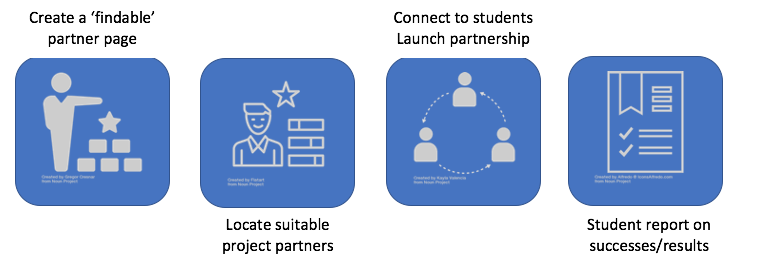The Technique
I was looking for experiential learning opportunities for my students, but I was new to Thunder Bay and teaching new courses. I heard about Riipen, a work-integrated learning and experiential learning platform with organizations throughout Canada and the world, so I signed up.Once I registered, I first took the approach of searching for projects using terms that were aligned to what I teach, at the level I teach — the level at which my learners need to work. I did this to see the potential matches for my class, though I didn’t have as much luck with this approach as I had hoped. As an alternative approach, I posted my class details and made my students available to organizations using Riipen. Using the space in this way, I was able to find a few great project partner matches.
With the addition of my course to the system, my students’ teams could connect with the partners that I determined fit the scope of the work we could do in our course. Teams could find some projects and ideas on their own, while others were made possible by connections made through Riipen.
How I Use It

- My first step is to detail my course within the Riipen space. The level of detail I put in will determine how many connections I can make with my industry partners. Adding tags that are standardized, universal terms from within my discipline will also help with my courses/projects ‘findability’. This detail will also help Riipen make suggestions to me about project partners that may fit my needs… and then… … we wait.
- As responses come in, I vet these queries to see if they fit with my course and learners. I respond to those that fit and invite further discussion. Our partners need to be extremely flexible with the timing and scope of the possible project. It is even possible for a partner to redefine their project terms to fit the students’ needs.
- The next step is to make a call to the partner, explaining I want to record a short interview with them about their product/problem/project. This meeting recording becomes the project pitch for students.
- I share the pitch with project teams during the start of assignment.
- And, we find a partnership that works for both! At this point, I step back and let the partnership develop.
In future: Students could sign on and search for a project that they feel fits a course assignment’s rubric, that they could justify for approval. Once approved, students could then use Riipen as a collaboration space between the students and the industry partner to work as a virtual team.
Feedback from the Partner:
One of my industry partners sent this email after my group had provided a consultation and report for a start-up company.
“[Team leader] and the team,
Good morning!
Many many thanks for this. I simply love this. You have touched so many important aspects of the app. I will keep you guys posted on its update.
I will try to be there today at the presentation. Thanks for inviting me. Have a good one.
[Industry partner]“
A Short Task to Challenge You
How findable is your course?
- Identify 1-2 activities/projects in your course that your students work on that could benefit from a partnership.
- Describe these projects with enough details that, if online, they could generate potential partnerships through their ‘findability’ (common language, and terminology).
- Now create 3-4 ‘keywords’ (tags) that identify the most important part to be accomplished in your project.
- Try one of your keywords in Riipens ‘explore’ area.
Did you find any interesting results?
One Final Task
Is this something you can use in your classroom? How might you utilize it? If you want to share your results on social media, include a link to this lesson for context.


Feedback/Errata